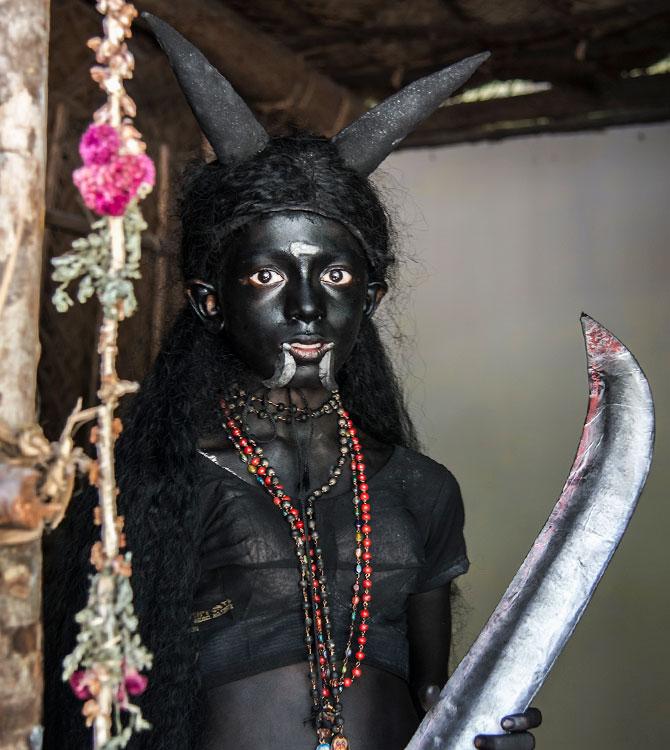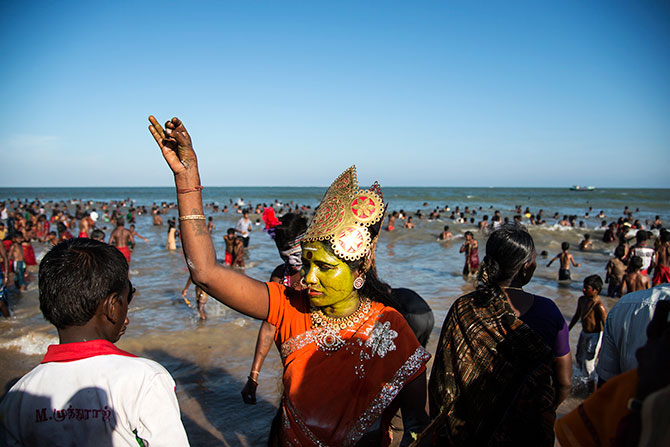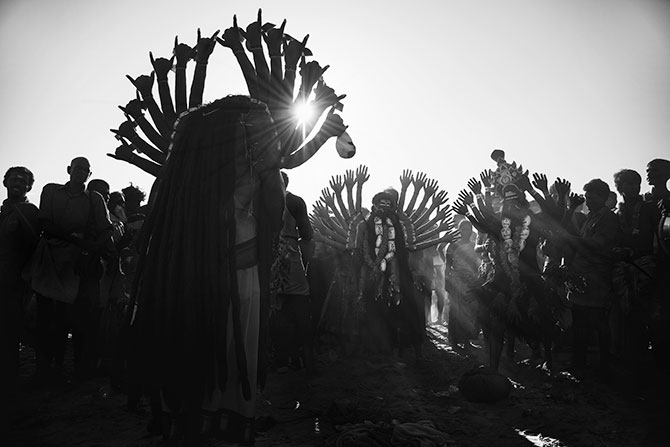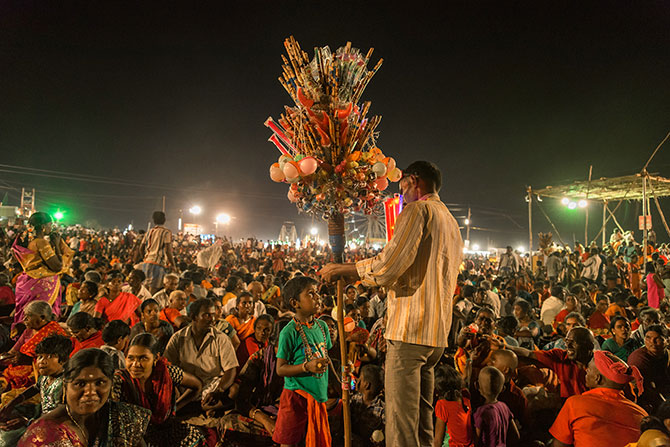 | « Back to article | Print this article |
Celebrations in Mutharamman Temple in Kulasekharapattinam, a coastal town in Tamil Nadu, have devotees visit the temple in an avatar of their choice. They could be dressed as kings or beggars, monkeys or demons, but the more popular is different forms of the Devi.
Once in their costumes, the devotees have to beg for alms to sustain themselves, an exercise, they believe, helps them overcome their ego, reports S Saraswathi.

Photograph Courtesy: Saravanan Dhandapani
Dussehra celebrations are on in full swing across the country. While the festivities may go by different names in different states, the fervour and enthusiasm remains the same.
Goddess Durga is worshipped in West Bengal, whereas it is Devi Chamundeswari in Karnataka. Gujarat celebrates with the colourful Dandiya Raas and Golu dolls find a special place in homes across Tamil Nadu.
The place to be in during Navratri in Delhi is the Ramlila Maidan. The centuries-old Kullu Dussehra is a major attraction in the state of Himachal Pradesh.
The Dussehra celebrations at the Mutharamman Temple in Kulasekharapattinam, a coastal town in Tamil Nadu, are popular but not so well known.
Located 20 km from Tiruchendur in Tuticorin district, this quaint village comes alive during the 10-day Dussehra festival. Over 15 lakh devotees visit the temple every year.
Anand, 42, a businessman from Madurai, who has been visiting the temple for the last 30 years, says that the popularity of the temple has grown tremendously over the years.
“I remember visiting the temple for the first time when I was around 11, with my grandmother. In those days, the temple was not as big or as popular.
“Today, huge mandapams have been built to accommodate the ever-increasing crowds.

Photograph Courtesy: Saravanan Dhandapani
“The Amman in the temple is very powerful; she can make all your wishes come true,” he states with conviction.
He says people also visit the temple to pray for relief from various illnesses. The mentally challenged and the handicapped find relief and solace in the temple.
More recently, the temple has become a popular tourist destination. People travelling to Kanyakumari or Tirunelveli stop here for a visit.
The temple’s history goes back thousands of years. Says Korkei Sivamani, a research scholar, studying temples in the area: “During the reign of the Pandya king Kulasekara Pandian, Kulasekharapattinam developed as a port town and trade flourished.
“The king set up an akkasalai (coin minting unit) in the town and plenty of goldsmiths resided in the area. It was their custom to pray at a ‘mound of mud’ they considered their deity. The deity had no form during that period.
‘It was only much later, in the 1900s, due to the efforts of Siddhar Ayyadurai (a saint) that the idol of the present deity came into being.”
Dussehra began to be celebrated in the temple in the early 19th century.
A unique feature of the celebrations in this temple is that devotees visit the temple in an avatar of their choice. They could be dressed as kings or beggars, monkeys or demons, but the more popular is different forms of the Devi.
Sivamani says the reason for this is that normally during Navratri, most homes in Tamil Nadu display Golu dolls.
“The theory is that God can be found in any form, or rather, that God resides in every form, however humble.
“They believe that during Dussehra, God will come to their home in some form and bless them. This very same idea is followed in principle at the Mutharamman Temple. But instead of dolls, we have real people,” he explains.
He further added that once in costume, the devotees have to beg for alms to sustain themselves.

Photograph Courtesy: Saravanan Dhandapani
“In ancient times, our saints used to beg to show that one should have no pride. So during the festival, people with high profile jobs, government officers, collectors, rich, powerful men come here to don avatars of monkeys and beggars, and this helps to reduce their ego. “Each one of us has a God within, but our arrogance, desire for material possessions and other worldly pleasures prevents these attributes from manifesting.
“Wearing a humble costume and begging helps to reduce this pride and bring out the divine qualities of man,” Sivamani reasons.
Prabhakaran, a 40-year-old vessel merchant, has been assuming the avatar of Goddess Kali for the last 10 years.
He says that devotees must be careful in their choice of who to dress up as.
“Mother Kali is one of the most powerful Gods. It is not easy to simply pick up any costume or make up. The preparations start almost 41 days in advance, when we begin our fast.
“We eat simple food once a day and stay away from all bad habits. At the temple, people come to us for blessings. The hairpiece alone weighs many kilos and those not true in their devotion will be unable to bear this weight,” he warns.
Vairavamurthy, 50, lives in Kulasekharapattinam village and is a priest at a local temple.
He has witnessed many celebrations and describes the electrifying atmosphere in the village during Dussehra.
“Each night, the Devi, adorned with flowers and jewels but taking on different forms, is taken out in a procession through the village and people offer her their prayers. Nine different forms for the nine days of Navratri.”
On Vijayadasami, the tenth day, the Devi assumes the magnificent form of Annai Parasakthi and at midnight the procession moves to the eastern shores of Kulasekharapatnam to witness the Samharam.
Legend has it that on this day the Devi destroyed the all-powerful Mahisasura, the man with a buffalo head, signifying the triumph of good over evil.
From then on, she came to be known as Mahisasura Marthini, the slayer of the buffalo-headed demon.

Photograph Courtesy: Saravanan Dhandapani
During the 10 days of the festival, forgotten dance forms such as Karagattam, Oyilattam, and Mayilattam, are performed as well as historic plays, old films, music played on traditional instruments and folk songs.
The rhythmic beating of the drums, shehnai and taal resonate in the air as thousands throng the village in their different costumes. Most are half delirious with devotion and dance with abandon.
Celebrations reach a fever pitch on the last day, as lakhs of devotees and visitors come to witness the Samharam at the beach.
At the end of the festivities, the devotees sleep on the beach and leave at dawn the next day after a holy dip in the waters.
Sivamani says that this 100-year-old ritual of donning the costume, make-up and begging for alms is simply an exercise in achieving Anandamaya Kosha (a state of ultimate bliss and liberation).